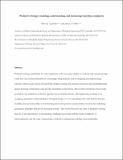| dc.contributor.author | Lopatkin, Allison J. | |
| dc.contributor.author | Collins, James J. | |
| dc.date.accessioned | 2021-09-21T19:45:14Z | |
| dc.date.available | 2021-09-21T19:45:14Z | |
| dc.date.issued | 2020-05 | |
| dc.date.submitted | 2020-04 | |
| dc.identifier.issn | 1740-1526 | |
| dc.identifier.issn | 1740-1534 | |
| dc.identifier.uri | https://hdl.handle.net/1721.1/132619 | |
| dc.description.abstract | Predictive biology is the next great chapter in synthetic and systems biology, particularly for microorganisms. Tasks that once seemed infeasible are increasingly being realized such as designing and implementing intricate synthetic gene circuits that perform complex sensing and actuation functions, and assembling multi-species bacterial communities with specific, predefined compositions. These achievements have been made possible by the integration of diverse expertise across biology, physics and engineering, resulting in an emerging, quantitative understanding of biological design. As ever-expanding multi-omic data sets become available, their potential utility in transforming theory into practice remains firmly rooted in the underlying quantitative principles that govern biological systems. In this Review, we discuss key areas of predictive biology that are of growing interest to microbiology, the challenges associated with the innate complexity of microorganisms and the value of quantitative methods in making microbiology more predictable. | en_US |
| dc.description.sponsorship | Defence Threat Reduction Agency (Grant HDTRA1-15-1-0051) | en_US |
| dc.language.iso | en | |
| dc.publisher | Springer Science and Business Media LLC | en_US |
| dc.relation.isversionof | http://dx.doi.org/10.1038/s41579-020-0372-5 | en_US |
| dc.rights | Creative Commons Attribution-Noncommercial-Share Alike | en_US |
| dc.rights.uri | http://creativecommons.org/licenses/by-nc-sa/4.0/ | en_US |
| dc.source | Prof. Collins | en_US |
| dc.title | Predictive biology: modelling, understanding and harnessing microbial complexity | en_US |
| dc.type | Article | en_US |
| dc.identifier.citation | Lopatkin, Allison J. and James J. Collins. "Predictive biology: modelling, understanding and harnessing microbial complexity." Nature Reviews Microbiology 18, 9 (September 2020): 507–520. © 2020 Springer Nature Limited | en_US |
| dc.contributor.department | Massachusetts Institute of Technology. Institute for Medical Engineering & Science | en_US |
| dc.contributor.department | Massachusetts Institute of Technology. Department of Biological Engineering | en_US |
| dc.relation.journal | Nature Reviews Microbiology | en_US |
| dc.eprint.version | Author's final manuscript | en_US |
| dc.type.uri | http://purl.org/eprint/type/JournalArticle | en_US |
| eprint.status | http://purl.org/eprint/status/PeerReviewed | en_US |
| dc.date.updated | 2021-09-21T14:05:26Z | |
| dspace.orderedauthors | Lopatkin, AJ; Collins, JJ | en_US |
| dspace.date.submission | 2021-09-21T14:05:27Z | |
| mit.journal.volume | 18 | en_US |
| mit.journal.issue | 9 | en_US |
| mit.license | OPEN_ACCESS_POLICY | |
| mit.metadata.status | Complete | en_US |
